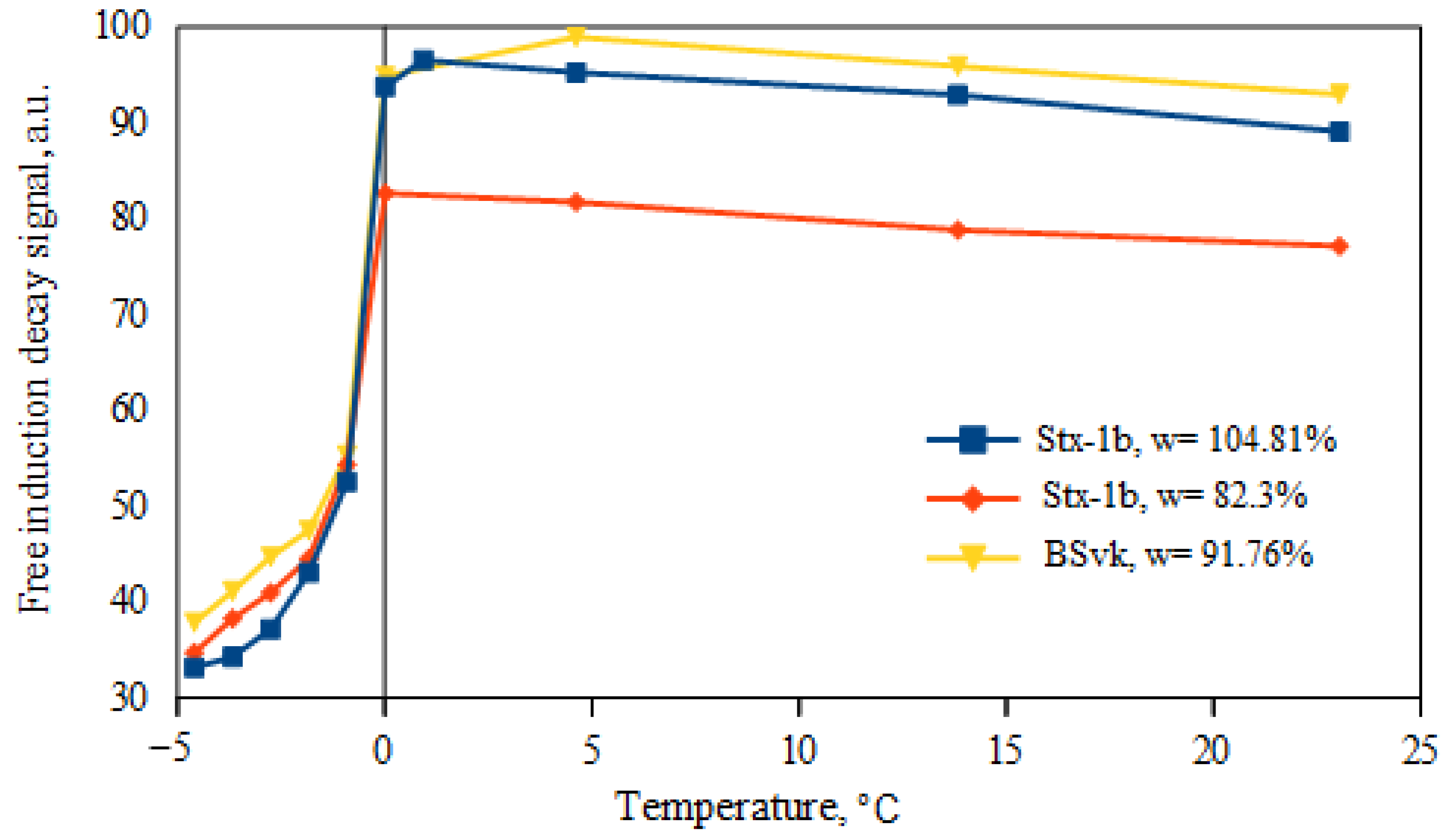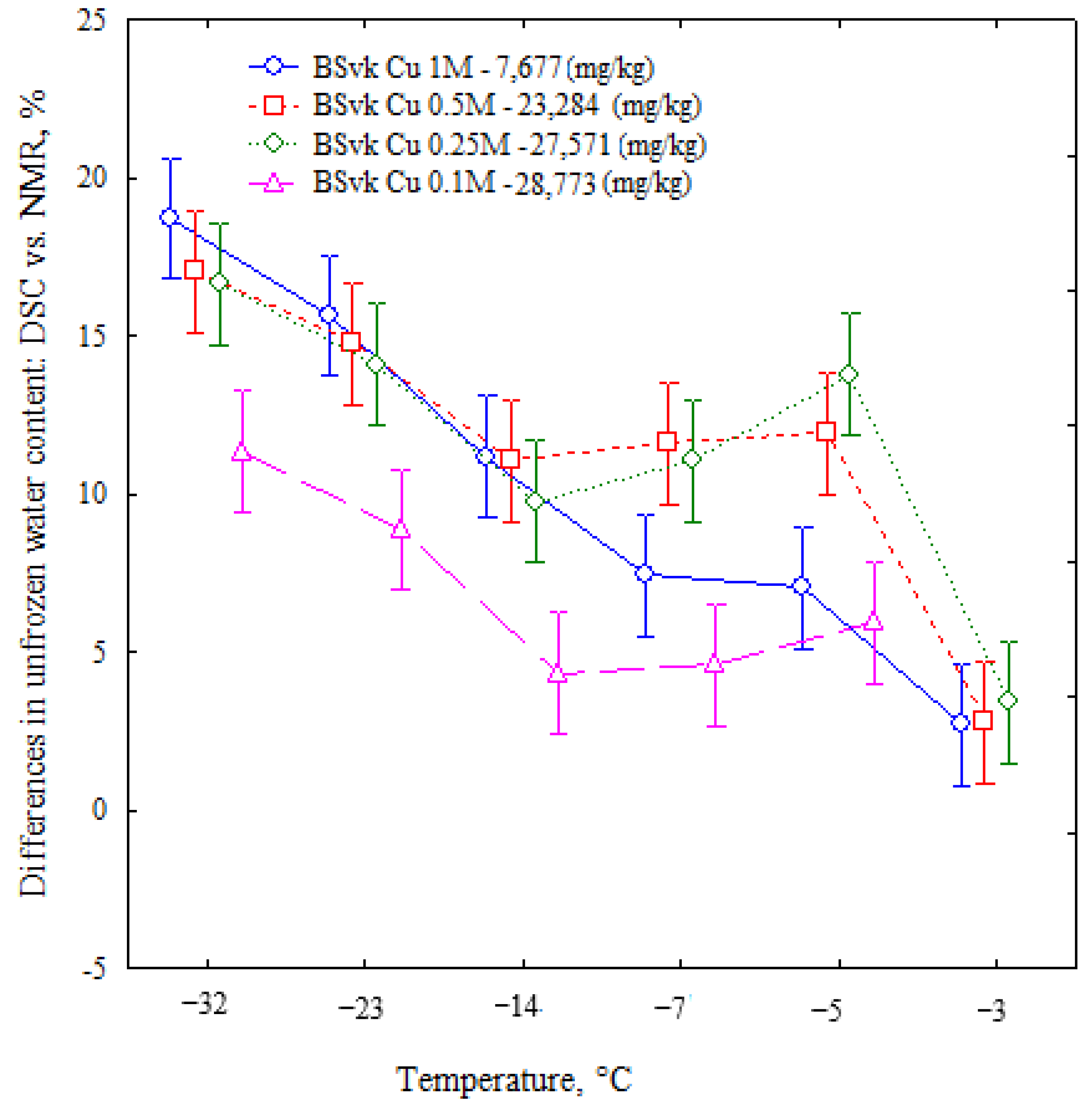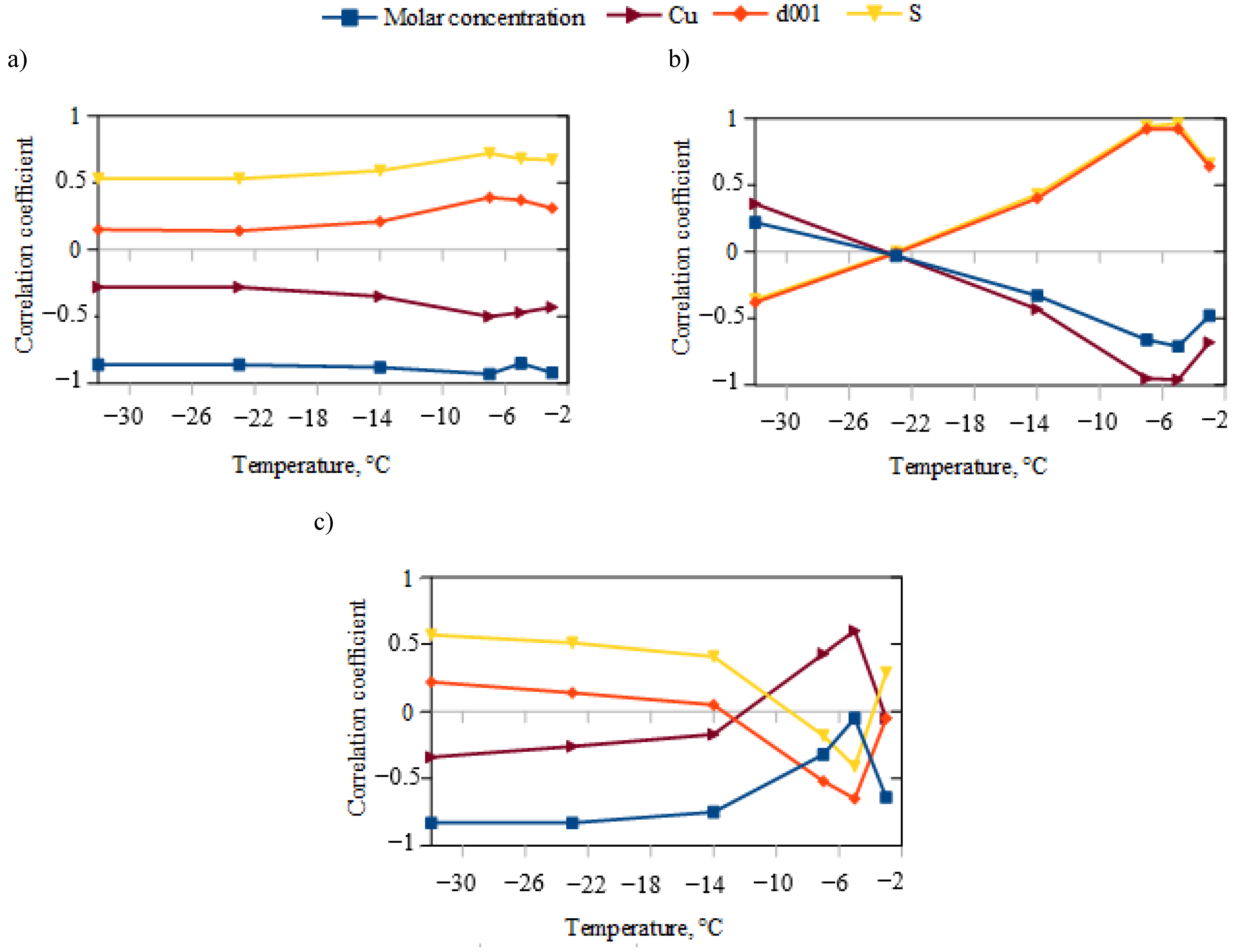Assessment of Unfrozen Water Content in Copper Bentonites Using the 1H NMR Technique: Optimization, the Method’s Limitation, and Comparative Analysis with DSC
Abstract
:1. Introduction
2. Materials and Methods
2.1. Materials
2.2. Methods
2.2.1. Preparation of Homoionic Forms and Properties of Bentonites
2.2.2. NMR Technique
NMR Equipment
NMR Procedure
Calculation of Unfrozen Water Content Based on NMR Technique
2.2.3. DSC and Calculation of Unfrozen Water Content Based on DSC Technique
3. Results and Discussion
3.1. Optimization of the Method for Determining Changes in Unfrozen Water Content Using the 1H NMR Technique
3.2. Comparison of Changes in Unfrozen Water Content Determined via DSC with those Determined via NMR in Copper-Enriched Bentonites
3.3. Analysis of the Relationship between Unfrozen Water Content, as Determined via DSC and NMR Techniques, and the Copper Concentration and Physicochemical Parameters of Bentonites
4. Conclusions
- The unfrozen water content in model bentonites determined using the optimized NMR method showed the best correlation with the DSC results. The utilization of the Bruker minispec mq20 instrument enabled rapid and efficient measurement of unfrozen water content changes during continuous temperature variation in water–clay systems.
- The unfrozen water content determined using the NMR method in bentonites contaminated with Cu ions was found to be approximately 2–18% lower compared to the results obtained via DSC.
- Differences in unfrozen water content determined using the DSC and NMR methods are statistically significant and depend on molar concentration, copper ion concentration, and temperature, as confirmed via ANOVA analysis.
- As the temperature increases, the differences in unfrozen water content between the DSC and NMR methods in bentonites contaminated with copper ions decrease in the temperature range from −32 °C to −2 °C. It is likely that at temperatures ≤ −14 °C, copper–water interactions are more predominant than water–water interactions.
- The largest differences in unfrozen water content (DSC vs. NMR) occur at low temperatures (≤−14 °C), especially at higher molar concentrations. Copper ions appear to be less mobile at lower molar concentrations (≤0.5M), possibly due to the weakly acidic environment and the binding of some copper ions and their subsequent transformation into a new mineral phase (atacamite). As the ionic strength of the solution increases, copper ion mobility rises, and water molecules hydrating copper ions become partially visible via NMR.
Author Contributions
Funding
Institutional Review Board Statement
Informed Consent Statement
Data Availability Statement
Conflicts of Interest
References
- Kgabi, D.P.; Ambushe, A.A. Characterization of South African Bentonite and Kaolin Clays. Sustainability 2023, 15, 12679. [Google Scholar] [CrossRef]
- Klik, B.; Holatko, J.; Jaskulska, I.; Gusiatin, M.Z.; Hammerschmiedt, T.; Brtnicky, M.; Liniauskienė, E.; Baltazar, T.; Jaskulski, D.; Kintl, A.; et al. Bentonite as a Functional Material Enhancing Phytostabilization of Post-Industrial Contaminated Soils with Heavy Metals. Materials 2022, 15, 8331. [Google Scholar] [CrossRef] [PubMed]
- Wang, H.; Chen, D.; Guo, R.; Tian, J.; Li, B. A Preliminary Study on the Improvement of Gangue/Tailing Cemented Fill by Bentonite: Flow Properties, Mechanical Properties and Permeability. Materials 2023, 16, 6802. [Google Scholar] [CrossRef] [PubMed]
- He, H.; Chai, K.; Wu, T.; Qiu, Z.; Wang, S.; Hong, J. Adsorption of Rhodamine B from Simulated Waste Water onto Kaolin-Bentonite Composites. Materials 2022, 15, 4058. [Google Scholar] [CrossRef] [PubMed]
- Matusewicz, M. The Microstructure of Bentonite Clay. Academic Dissertation for the Degree of Doctor of Philosophy; Research report No. 9; Department of Physics, University of Jyväskylä, Finland: Jyväskylä, Finland, 2008; ISBN 978-951-39-7605-7. [Google Scholar]
- Matusewicz, M.; Pulkkanen, V.-M.; Olin, M. Influence of sample preparation on MX-80 bentonite microstructure. Clay Miner 2016, 51, 189–195. [Google Scholar] [CrossRef]
- Koda, E.; Miszkowska, A.; Sieczka, A.; Osiński, P. Heavy metals contamination within restored landfill site in Poland. Environ. Geotech. 2020, 7, 512–521. [Google Scholar] [CrossRef]
- Nartowska, E.; Kozłowski, T.; Gawdzik, J. Assessment of the influence of copper and zinc on the microstructural parameters and hydraulic conductivity of bentonites on the basis of SEM tests. Heliyon 2019, 5, 7. [Google Scholar] [CrossRef]
- Nartowska, E. The effects of potentially toxic metals (copper and zinc) on selected physical and physico-chemical properties of bentonites. Heliyon 2019, 5, 10. [Google Scholar] [CrossRef]
- Angelaki, A.; Dionysidis, A.; Sihag, P.; Golia, E.E. Assessment of Contamination Management Caused by Copper and Zinc Cations Leaching and Their Impact on the Hydraulic Properties of a Sandy and a Loamy Clay Soil. Land 2022, 11, 290. [Google Scholar] [CrossRef]
- Feng, C.; Li, J.; Liu, J.; Chen, Z.; Jiang, W.; Huang, X.; Xue, Q. Mechanical properties evolution and microscopic mechanisms of arsenic and cadmium co-contaminated clayey soils. Bull. Eng. Geol. Environ. 2023, 82, 229. [Google Scholar] [CrossRef]
- Nartowska, E.; Kozłowski, T.; Kolankowska, M. Exchangeable cations (Cu2+, Zn2+) effects on unfrozen water content in clay-water system using 1H NMR method. Cold Reg. Sci. Technol. 2021, 192, 103403. [Google Scholar] [CrossRef]
- Nartowska, E.; Kozłowski, T. The Effect of the Concentration of Copper Ions on the Unfrozen Water Content in Bentonites Measured with the Use of DSC Method. Minerals 2022, 12, 632. [Google Scholar] [CrossRef]
- Ren, J.; Shoulong, Z.; Wang, C.; Vanapalli, S.K. The Measurement of Unfrozen Water Content and SFCC of a Coarse-Grained Volcanic Soil. J. Test. Eval. 2021, 51. [Google Scholar] [CrossRef]
- Jin, X.; Yang, W.; Gao, X.; Zhao, J.Q.; Li, Z.; Jiang, J. Modeling the unfrozen water content of frozen soil based on the absorption effects of clay surfaces. Water Resour. Res. 2020, 56, e2020WR027482. [Google Scholar] [CrossRef]
- Ren, J.; Fan, X.; Yu, X.; Vanapalli, S.; Zhang, S. Use of an artificial neural network model for estimation of unfrozen water content in frozen soils. Can. Geotech. J. 2023, 60, 1234–1248. [Google Scholar] [CrossRef]
- Kojima, Y.; Nakano, Y.; Kato, C.; Noborio, K.; Kamiya, K.; Horton, R. A New Thermo-Time Domain Reflectometry Approach to Quantify Soil Ice Content at Temperatures Near the Freezing Point. Cold Reg. Sci. Technol. 2020, 174, 103060. [Google Scholar] [CrossRef]
- Nartowska, E.; Kozłowski, T. The Effect of Freeze-Thaw Cycling and the Initial Mass of Water on the Unfrozen Water Content of Calcium Bentonites Modified by Copper Ions. Minerals 2022, 12, 66. [Google Scholar] [CrossRef]
- Akagawa, S.; Iwahana, G.; Watanabe, K.; Chuvilin, E.M.; Istomin, V.A. Improvement of Pulse-NMR technology for determining the unfrozen water content in frozen soil. In Proceedings of the 10th International Conference in Permafrost, Salekhard, Russia, 25–29 June 2012. [Google Scholar]
- Kruse, A.M.; Darrow, M.M.; Akagawa, S. Improvements in Measuring Unfrozen Water in Frozen Soils Using the Pulsed Nuclear Magnetic Resonance Method. J. Cold Reg. Eng. 2017, 32, 04017016. [Google Scholar] [CrossRef]
- Li, B.; Huang, L.; Lv, X.; Ren, Y. Variation features of unfrozen water content of water-saturated coal under low freezing temperature. Sci. Rep. 2021, 11, 15398. [Google Scholar] [CrossRef]
- He, Y.; Xu, Y.; Lv, Y.; Nie, L.; Kong, F.; Yang, S.; Wang, H.; Li, T. Characterization of unfrozen water in highly organic turfy soil during freeze–thaw by nuclear magnetic resonance. Eng. Geol. 2023, 312, 106937. [Google Scholar] [CrossRef]
- Kruse, A.M.; Darrow, M.M. Absorbed cation effects on unfrozen water in fine-grained frozen soilusing pulsed nuclear magnetic resonance. Cold Reg. Sci. Technol. 2017, 142, 42–54. [Google Scholar] [CrossRef]
- Guala, S.D.; Vega, F.A.; Covelo, E.F. The dynamics of heavy metals in plant–soil interactions. Ecol. Model. 2010, 221, 1148–1152. [Google Scholar] [CrossRef]
- Bayer, J.V.; Jaeger, F.; Schaumann, G.E. Proton Nuclear Magnetic Resonance (NMR) Relaxometry in Soil Science Applications. Open Magn. Reson. J. 2010, 3, 15–26. [Google Scholar] [CrossRef]
- Akitt, J. Proton chemical shifts of water in cationic hydration complexes and their contribution to water shifts in electrolyte solutions. J. Chem. Soc. Dalton Trans. 1973, 1, 29–42. [Google Scholar] [CrossRef]
- Saerbeck, T.; Pereiro, J.; Wampler, J.; Stanley, J.; Wingert, J.; Shpyrko, O.G.; Schuller, I.K. Ferromagnetism in partially oxidized CuCl. J. Magn. Magn. Mater. 2013, 346, 161–165. [Google Scholar] [CrossRef]
- PN-ISO 9297:1994; Polish Norm. Water Quality—Determination of Chlorides—Titrimetric Method with Silver Nitrate in the Presence of Chromate as an Indicator (Mohr Method). Polish Committee for Standardization: Warsaw, Poland, 1994.
- Stępkowska, E.T. Simple method of crystal phase water, specific surface and clay mineral content estimation in natural clays. Stud. Geotechn. 1973, IV, 21–36. [Google Scholar]
- Kozłowski, T.; Nartowska, E. Unfrozen water content in representative bentonites of different origin subjected to cyclic freezing and thawing. Vadose Zone J. 2013, 12, 1–11. [Google Scholar] [CrossRef]
- Tice, A.R.; Anderson, D.M.; Sterrett, K.F. Unfrozen water contents of submarine permafrost determined by nuclear magnetic resonance. Eng. Geol. 1981, 18, 1–4. [Google Scholar] [CrossRef]
- Bloembergen, N.; Morgan, L.O. Proton Relaxation Times in Paramagnetic Solutions. Effects of Electron Spin Relaxation. J. Chem. Phys. 1961, 34, 842. [Google Scholar] [CrossRef]
- Mavrovic, A.; Lara, R.P.; Berg, A.; Demontoux, F.; Royer, A.; Roy, A. Soil dielectric characterization during freeze–thaw transitions using an L-band coaxial probe. Hydrol. Earth Syst. Sci. 2021, 25, 1117–1131. [Google Scholar] [CrossRef]
- Wciślik, S.; Mukherjee, S. Evaluation of three methods of static contact angle measurements for TiO2 nanofluid droplets during evaporation. Phys. Fluids 2022, 34, 062006. [Google Scholar] [CrossRef]
- Lunghi, A. Spin-Phonon Relaxation in Magnetic Molecules: Theory, Predictions and Insights. In Computational Modelling of Molecular Nanomagnets; Rajaraman, G., Ed.; Challenges and Advances in Computational Chemistry and Physics; Springer: Cham, Switzerland, 2023; Volume 34. [Google Scholar] [CrossRef]
- Burlamacchi, L.; Martini, G. Molecular dynamics in water solutions adsorbed on porous solids studied by esr of paramagnetic probes. In Magnetic Resonance in Colloid and Interface Science; Fraissard, J.P., Resing, H.A., Eds.; D. Reidel Publishing Company: Dordrecht, The Netherlands; Boston, MA, USA; London, UK, 1979. [Google Scholar]
- Schnitzer, M.; Hansen, E.H. Organo-metallic interactions in soils 8. An evaluation of methods for the determination of stability constants of metal-fulvic acid complexes. Soil Sci. 1970, 109, 333. [Google Scholar] [CrossRef]
- Wang, H.; Shibue, T.; Komine, H. Hydration and dehydration of water of bentonite: A solid-state 1H magic-angle spinning NMR study. Chem. Phys. 2020, 536, 110796. [Google Scholar] [CrossRef]
- Sare, E.J.; Moynihan, C.T.; Angell, C.A. Proton magnetic resonance chemical shifts and the hydrogen bond in concentrated aqueous electrolyte solutions. J. Phys. Chem. 1973, 77, 1869–1876. [Google Scholar] [CrossRef]




| Stx-1b | BSvk | BSvk Cu | ||||
|---|---|---|---|---|---|---|
| 1 M | 0.5 M | 0.25 M | 0.1 M | |||
| Copper & | 8.97 ± 0.13 | 6.28 ± 0.06 | 7677 ± 70 | 28,773 ± 162 | 27,571 ± 90 | 23,284 ± 121 |
| Mineral composition + | 75% Sm 20% Op 5% Qz | 92% Sm 5% Qz 3% Bt | 92% Sm 5% Qz 3% Bt | 86% Sm 5% Qz 3% Bt 6% Atc | 87% Sm 5% Qz 3% Bt 5% Atc | 89% Sm 5% Qz 3% Bt 3% Atc |
| d001 + | 14.87 | 14.88 | 12.48 | 12.31 | 12.34 | 12.38 |
| Clay * | 18.50 | 19.80 | 20.50 | 16.00 | 18.50 | 18.00 |
| Silt * | 81.50 | 80.20 | 79.50 | 84.00 | 81.50 | 82.00 |
| Specific surface area # | 568 | 671 | 460 | 203 | 189 | 183 |
| Stx−1b | |||||||
|---|---|---|---|---|---|---|---|
| Temperature | DSC | NMR * | Difference DSC/NMR | ||||
| (1) in This Study | (2) acc. Akagawa (2012) [19] | (3) acc. Li et al. (2021) [21] | (1) | (2) | (3) | ||
| −32 °C | 21.08 ± 1.04 | 20.53 ± 1.43 | 21.25 ± 0.42 | 17.31 ± 1.66 | 0.55 | −0.17 | 3.77 |
| −23 °C | 22.60 ± 1.10 | 23.14 ± 2.25 | 23.12 ± 0.26 | 20.25 ± 1.10 | −0.54 | −0.52 | 2.34 |
| −14 °C | 26.37 ± 1.07 | 26.80 ± 2.63 | 26.78 ± 0.43 | 24.40 ± 1.02 | −0.42 | −0.41 | 1.97 |
| −7 °C | 32.91 ± 1.37 | 32.73 ± 2.00 | 30.39 ± 1.11 | 30.73 ± 2.15 | 0.18 | 2.52 | 2.18 |
| −5 °C | 35.62 ± 1.63 | 35.86 ± 3.46 | 35.86 ± 1.24 | 33.95 ± 1.18 | −0.24 | −0.24 | 1.66 |
| −3 °C | 40.14 ± 2.28 | 40.45 ± 3.06 | 40.48 ± 1.25 | 38.66 ± 2.39 | −0.30 | −0.34 | 1.48 |
| BSvk | |||||||
| −32 °C | 23.51 ± 1.71 | 19.75 ± 0.35 | 20.23 ± 0.59 | 17.97 ± 0.96 | 3.76 | 3.28 | 5.54 |
| −23 °C | 24.23 ± 0.85 | 23.84 ± 0.79 | 24.41 ± 0.36 | 22.26 ± 1.62 | 0.39 | −0.18 | 1.97 |
| −14 °C | 27.03 ± 0.53 | 26.62 ± 1.22 | 27.25 ± 0.67 | 25.45 ± 1.87 | 0.41 | −0.22 | 1.58 |
| −7 °C | 32.20 ± 1.23 | 33.71 ± 1.77 | 34.50 ± 1.09 | 32.81 ± 2.31 | −1.51 | −2.30 | −0.61 |
| −5 °C | 36.96 ± 3.16 | 37.26 ± 2.14 | 38.13 ± 1.41 | 36.45 ± 2.65 | −0.30 | −1.17 | 0.51 |
| −3 °C | 39.05 ± 1.55 | 45.10 ± 3.25 | 46.17 ± 2.97 | 44.33 ± 3.49 | −6.05 | −7.12 | −5.28 |
| T | DSC | NMR * | Difference DSC/NMR | T | DSC | NMR * | Difference DSC/NMR |
|---|---|---|---|---|---|---|---|
| BSvk 1 M | BSvk 0.5 M | ||||||
| −32 °C | 22.43 ± 1.66 | 4.26 ± 0.94 | 18.17 | −32 °C | 23.03 ± 2.32 | 5.43 ± 1.00 | 17.60 |
| −23 °C | 22.43 ± 1.66 | 7.48 ± 0.53 | 14.95 | −23 °C | 22.47 ± 1.45 | 7.74 ± 0.51 | 14.73 |
| −14 °C | 24.78 ± 2.05 | 14.6 ± 1.75 | 10.18 | −14 °C | 24.16 ± 1.60 | 13.56 ± 1.69 | 10.60 |
| −7 °C | 31.95 ± 1.84 | 24.97 ± 0.94 | 6.98 | −7 °C | 28.25 ± 1.53 | 17.67 ± 1.30 | 10.58 |
| −5 °C | 36.00 ± 2.36 | 30.23 ± 0.81 | 5.77 | −5 °C | 32.79 ± 1.56 | 28.08 ± 1.70 | 4.71 |
| −3 °C | 38.04 ± 1.72 | 35.28 ± 0.71 | 2.76 | −3 °C | 34.40 ± 1.75 | 32.76 ± 2.36 | 1.64 |
| BSvk 0.25 M | BSvk 0.1 M | ||||||
| −32 °C | 20.04 ± 1.53 | 4.47 ± 0.22 | 15.57 | −32 °C | 17.51 ± 1.38 | 5.20 ± 0.56 | 12.31 |
| −23 °C | 20.27 ± 1.18 | 7.04 ± 0.38 | 13.23 | −23 °C | 17.51 ± 1.38 | 7.67 ± 0.27 | 9.84 |
| −14 °C | 22.21 ± 0.68 | 12.9 ± 1.04 | 9.31 | −14 °C | 18.95 ± 1.51 | 13.57 ± 0.6 | 5.38 |
| −7 °C | 28.84 ± 0.51 | 17.73 ± 0.58 | 11.11 | −7 °C | 23.81 ± 1.21 | 18.79 ± 1.43 | 5.02 |
| −5 °C | 32.90 ± 2.68 | 27.56 ± 0.66 | 5.34 | −5 °C | 28.73 ± 0.69 | 28.93 ± 1.62 | −0.20 |
| −3 °C | 34.56 ± 0.47 | 31.29 ± 1.44 | 3.27 | −3 °C | 29.10 ± 0.95 | 33.04 ± 1.39 | −3.94 |
| Sum of Squares | Degrees of Freedom | Mean Square | F-Test Value | p-Value | Significance | |
|---|---|---|---|---|---|---|
| Dependent variable: The unfrozen water content determined using NMR technique | ||||||
| Intercept | 21,131.04 | 1 | 21,131.04 | 16,939.65 | 0.0000 | |
| Temperature (T) | 6756.04 | 5 | 1351.21 | 1083.19 | 0.0000 | *** |
| Molar (M) or copper concentration (Cu) | 149.69 | 3 | 49.90 | 40.00 | 0.0000 | *** |
| T M or T Cu | 167.67 | 15 | 11.18 | 8.96 | 0.0000 | *** |
| Error | 59.88 | 48 | 1.25 | |||
| Dependent variable: Differences between unfrozen water content determined using DSC and NMR techniques | ||||||
| Intercept | 6691.42 | 1 | 6691.42 | 2431.10 | 0.0000 | |
| Temperature (T) | 1511.15 | 5 | 302.23 | 109.80 | 0.0000 | *** |
| Molar (M) or copper concentration (Cu) | 497.38 | 3 | 165.79 | 60.24 | 0.0000 | *** |
| T M or T Cu | 112.18 | 15 | 7.48 | 2.72 | 0.0044 | ** |
| Error | 132.12 | 48 | 2.75 | |||
Disclaimer/Publisher’s Note: The statements, opinions and data contained in all publications are solely those of the individual author(s) and contributor(s) and not of MDPI and/or the editor(s). MDPI and/or the editor(s) disclaim responsibility for any injury to people or property resulting from any ideas, methods, instructions or products referred to in the content. |
© 2023 by the authors. Licensee MDPI, Basel, Switzerland. This article is an open access article distributed under the terms and conditions of the Creative Commons Attribution (CC BY) license (https://creativecommons.org/licenses/by/4.0/).
Share and Cite
Nartowska, E.; Kanuchova, M.; Kozáková, Ľ. Assessment of Unfrozen Water Content in Copper Bentonites Using the 1H NMR Technique: Optimization, the Method’s Limitation, and Comparative Analysis with DSC. Materials 2023, 16, 7577. https://doi.org/10.3390/ma16247577
Nartowska E, Kanuchova M, Kozáková Ľ. Assessment of Unfrozen Water Content in Copper Bentonites Using the 1H NMR Technique: Optimization, the Method’s Limitation, and Comparative Analysis with DSC. Materials. 2023; 16(24):7577. https://doi.org/10.3390/ma16247577
Chicago/Turabian StyleNartowska, Edyta, Maria Kanuchova, and Ľubica Kozáková. 2023. "Assessment of Unfrozen Water Content in Copper Bentonites Using the 1H NMR Technique: Optimization, the Method’s Limitation, and Comparative Analysis with DSC" Materials 16, no. 24: 7577. https://doi.org/10.3390/ma16247577
APA StyleNartowska, E., Kanuchova, M., & Kozáková, Ľ. (2023). Assessment of Unfrozen Water Content in Copper Bentonites Using the 1H NMR Technique: Optimization, the Method’s Limitation, and Comparative Analysis with DSC. Materials, 16(24), 7577. https://doi.org/10.3390/ma16247577






